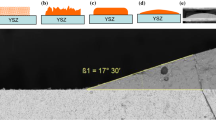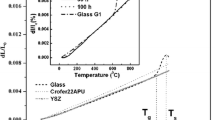Abstract
A key problem in the fabrication of planar solid oxide fuel cells is the sealing of the metallic interconnect to the ceramic electrolyte. The sealing material must be gas-tight, stable in different atmospheres at high temperature, chemically compatible with the other cell components and resistant to thermal stresses. Glass–ceramic sealants are good candidates because of their high mechanical properties and the possibility to use a wide range of chemical compositions to control some physical properties like viscosity or coefficient of thermal expansion (CTE). In this work, glass sealants were synthesized using a sol–gel route, which generally allows to obtain both homogeneity at a nanoscale and reduction of the processing temperature. The studied glasses were based on the system BaO–B2O3–Al2O3–SiO2 with varying amounts of CaO and MgO additions. Dilatometry, differential thermal analysis and hot-stage microscopy were the techniques used to determine optimal thermal treatment for sealing operation (880 °C with a dwell time of 10 h). The thermomechanical properties of the sealants were improved after sealing by a thermal treatment transferring the sealant into a favourable partially polycrystalline state. Gas-tightness tests performed after joining and 100 h ageing treatment at 800 °C under air of steel-sealant-steel assemblies highlighted that 4 of the selected glass chemical compositions remained impermeable. Joining degradations, crystalline phases evolution and CTE of these glasses were analysed. Electrical resistivities were larger than 105 Ω cm at 700 °C. On the basis of these results, four glasses were identified as promising candidates for this application.









Similar content being viewed by others
References
Steele BCH, Heinzel A (2001) Materials for fuel-cell technologies. Nature 414:345–352
Haile SM (2003) Fuel cell materials and components. Acta Mater 51:5981–6000
Buchkremer HP, Conradt R (2010) Durable sealing concepts with glass sealants or compression seals. In: Vielstich W, Gasteiger HA, Lamm A, Yokokawa H (eds) Handbook of fuel cells: fundamentals, technology and applications. Wiley, Hoboken
Blum L, Gross SM, Malzbender J et al (2011) Investigation of solid oxide fuel cell sealing behavior under stack relevant conditions at FZJ. J Power Sources 196:7175–7181
Mahapatra MK, Lu K (2010) Thermochemical compatibility of a seal glass with different solid oxide cell components. Int J Appl Ceram Technol 7:10–21
Fergus JW (2005) Sealants for solid oxide fuel cells. J Power Sources 147:46–57
Lessing PA (2007) A review of sealing technologies applicable to solid oxide electrolysis cells. J Mater Sci 42:3465–3476. doi:10.1007/s10853-006-0409-9
Mahapatra MK, Lu K (2010) Seal glass for solid oxide fuel cells. J Power Sources 195:7129–7139
Sohn SB, Choi SY, Kim GH, Song HS, Kim GD (2002) Stable sealing glass for planar oxide fuel cell. J Noncryst Solids 297:103–112
Flugel A, Dolan MD, Varshneya AK et al (2007) Development of an improved devitrifiable fuel cell sealing glass I. Bulk properties. Electrochem Soc 154:B601–B608
Dolan MD, Misture ST (2007) Development of an improved devitrifiable fuel cell sealing glass II. Crystallization behavior and structures of crystalline phases. Electrochem Soc 154:B700–B711
Kerstan M, Russel C (2011) Barium silicates as high thermal expansion seals for solid oxide fuel cells studied by HT-XRD. J Power Sources 196:7578–7584
Meinhardt KD, Kim DS, Chou YS, Weil KS (2008) Synthesis and properties of a barium aluminosilicate solid oxide fuel cell glass–ceramic sealant. J Power Sources 182:188–196
Goel A, Tulyaganov DU, Kharton VV, Yaremchenko AA et al (2009) Optimization of La2O3-containing diopside based glass-ceramic sealants for fuel cell applications. J Power Sources 189:1032–1043
Ghosh S, Sharma AD, Mukhopadhyay AK, Kundu P, Basu RN (2010) Effect of BaO addition on magnesium lanthanum alumino borosilicate-based glass-ceramic sealant for anode-supported solid oxide fuel cell. Int J Hydrog Energy 35:272–283
Yang Z, Stevenson JW, Meinhardt KD (2003) Chemical interactions of barium–calcium–aluminosilicate-based sealing glasses with oxidation resistant alloys. Solid State Ionics 160:213–225
Peng L, Zhu Q (2009) Thermal cycle stability of BaO–B2O3–SiO2 sealing glass. J Power Sources 194:880–885
Batfalsky P, Haanappel VAC, Malzbender J, Menzler NH et al (2006) Chemical interaction between glass–ceramic sealants and interconnect steels in SOFC stacks. J Power Sources 155:128–137
Ghosh S, Sharma AD, Kundu P, Mahanty S, Basu RN (2008) Development and characterizations of BaO–CaO–Al2O3–SiO2 glass–ceramic sealants for intermediate temperature solid oxide fuel cell application. J Noncryst Solids 354:4081–4088
Haanappel VAC, Shemet V, Gross SM, Koppitz T, Menzler NH et al (2005) Behaviour of various glass–ceramic sealants with ferritic steels under simulated SOFC stack conditions. J Power Sources 150:86–100
Wang SF, Hsu YF, Lu HC, Lo SC, Cheng CS (2012) B2O3-free SiO2–Al2O3–SrO–La2O3–ZnO–TiO2 glass sealants for intermediate temperature solid oxide fuel cell applications. J Int Hydrog Energy 37:5901–5913
Smeacetto F, Salvo M, Ferraris M, Casalegno V, Asinari P (2008) Glass and composite seals for the joining of YSZ to metallic interconnect in solid oxide fuel cells. J Eur Ceram Soc 28:611–616
Smeacetto F, Salvo M, D’Herin Bytner FD, Leone P, Ferraris M (2010) New glass and glass–ceramic sealants for planar solid oxide fuel cells. J Eur Ceram Soc 30:933–940
Coillot D, Méar FO, Nonnet H, Montagne L (2012) New viscous sealing glasses for electrochemical cells. Int J Hydrog Energy 37:9351–9358
Hsu JH, Kim CW, Brow RK, Szabo J, Crouch R, Baird R (2014) An alkali-free barium borosilicate viscous sealing glass for solid oxide fuel cells. J Power Sources 270:14–20
Tredway HK, Risbud SH (1988) Gel synthesis of glass powders in the BaO–Al2O3–SiO2 system. J Noncryst Solids 100:278–283
Lee I, Covino J (1994) Sol–gel synthesis of monoclinic phase of barium aluminosilicate ceramics. Mater Res Bull 29:55–62
Makishima A, Nagata T (1988) Application of the sol–gel process to lower the melting temperature of glaze. J Noncryst Solids 100:519–522
Puig J, Ansart F, Lenormand P, Antoine L, Dailly J (2011) Sol–gel synthesis and characterization of barium (magnesium) aluminosilicate glass sealants for solid oxide fuel cells. J Noncryst Solids 357:3490–3494
Gross SM, Koppitz T, Remmel J, Bouche JB, Reisgen U (2006) Joining properties of a composite glass–ceramic sealant. Fuel Cells Bull 9:12–15
Payao JC, Schmidt W, Schroeder G (2000) Fundamentos de ensaio de vazamento e estanqueidade. Forschungszentrum Juelich GmbH, Jülich
Bansal NP, Gamble EA (2005) Crystallization kinetics of a solid oxide fuel cell seal glass by differential thermal analysis. J Power Sources 147:107–115
Sun T, Xiao H, Guo W, Hong X (2010) Effect of Al2O3 content on BaO–Al2O3–B2O3–SiO2 glass sealant for solid oxide fuel cell. Ceram Int 36:821–826
Geasee P, Schwickert T, Diekmann U, Conradt R (2001) In: Heinrich JG, Aldinger F (eds) Ceramic materials and components for engines. Wiley, Weinheim, Germany, pp 57–62
Lara C, Pascual MJ, Keding R, Duran A (2006) Electrical behaviour of glass–ceramics in the systems RO–BaO–SiO2 (R = Mg, Zn) for sealing SOFCs. J Power Sources 157:377–384
Acknowledgements
Authors thanks ADEME (Agence De l’Envivronnement et de la Maîtrise de l’Energie) and EIFER (European Institute For Energy Research) for their financial support.
Author information
Authors and Affiliations
Corresponding author
Rights and permissions
About this article
Cite this article
Puig, J., Ansart, F., Lenormand, P. et al. Development of barium boron aluminosilicate glass sealants using a sol–gel route for solid oxide fuel cell applications. J Mater Sci 51, 979–988 (2016). https://doi.org/10.1007/s10853-015-9428-8
Received:
Accepted:
Published:
Issue Date:
DOI: https://doi.org/10.1007/s10853-015-9428-8




